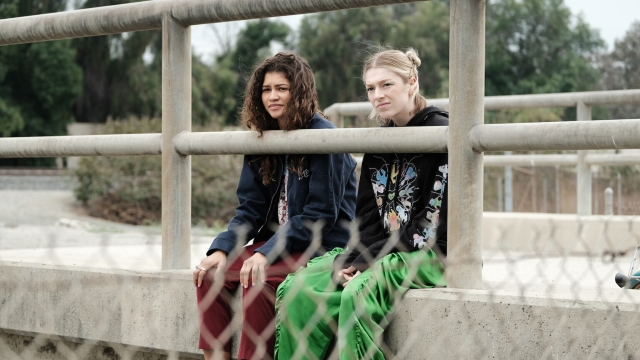


If Your Kids Are Secretly Watching HBO’s ‘Euphoria,’ You Should Be Worried

By ALLISON SCHUSTER
-
I remember sneaking around my basement as a kid to catch episodes of “Glee,” a television series many parents deemed controversial due to its display of teen pregnancy. It’s difficult to imagine that show, with its messages of community, acceptance, and hope, being viewed as contentious a decade ago when teens today obsess over the jarring and distasteful HBO smash-hit “Euphoria.”
The show “Euphoria” is enjoying record-breaking viewership in its second season and has cultivated a vocal cult following. It was the number one most in-demand show in the United States last month. The series follows recovering drug addict Rue and fellow high school classmates Cassie, Jules, Nate, Maddy, Fezco, and Ash as they navigate backstabbing friendships, deteriorating family lives, and dismal mental health.
Overly graphic sex scenes, extreme drug use, and paralyzing mental struggles plague every leading character. Everything from the show’s overall crude nature to the ultra-harsh lighting choices create a constant sense of darkness in the young characters’ lives. The show is a bleak and aggressive depiction of high school life and lacks aesthetic beauty.
Wildly Inappropriate and Unrelatable
The show’s vulgar characterization of such risqué themes to a vulnerable audience is unlike previous shows of its kind, Parents Television and Media Council Program Director Melissa Henson told The Federalist.
“There’s a near constant barrage of expletives and foul language. This show averages probably about 100 ‘F words’ per episode. But beyond that, the sexualized depictions of high schoolers I find very troubling [ as well as] the recreational drug use, recreational alcohol use, and the fact that there’s no real condemnation for any of this behavior,” Henson said. “It’s just presented as this is the way it is. And while that may be the reality for a segment of the population, I think it is certainly not the reality for most teenagers.”
This behavior actually defies reality for Gen Z, as teens today are less likely to drink alcohol, abuse drugs, get in physical fights, or have sex than previous generations. The Federalist’s Emily Jashinsky commented about this “puzzling disconnect” when the show first came out.
The show also has extreme amounts of nudity. The actress playing Cassie, 24-year-old Sydney Sweeney, even had to request that the show’s creator reduce the number of scenes featuring her topless, which he did. Nonetheless, Cassie is naked a lot this season, especially in episode two, when nearly the first five minutes were very intensely focused on her naked body.
Particularly Vulnerable Audience
The second season, which premiered last month, has garnered a significantly wider viewership than its first season’s pre-lockdown audience. This newfound popularity risks glorifying the show’s themes with a generation of teens who were isolated during the pandemic and are acutely unfamiliar with the typical high school experience. It creates the false impression that this is normal high school-age behavior.
It’s also much easier than it was even a decade ago for high schoolers to access the show without their parents knowing, and they can easily share it on social media. Despite what HBO says publicly, the show’s marketing attracts a high school demographic, and the high school setting naturally appeals primarily to high schoolers. Lead actress Zendaya was also a former Disney star, whose fan base largely includes high school-aged students.
U.S. Attorney General Vivek Murthy issued an advisory in December to highlight the urgency of the burgeoning mental health crisis confronting America’s youth. With rates of depression and suicidal ideation on the rise, “Euphoria” offers anything but an uplifting and encouraging picture for children, and actively encourages dangerous coping mechanisms. Rue, for example, constantly melts down on screen and insists she doesn’t want to live in this world anymore. “Euphoria” even offers a step-by-step tutorial for teens on how to turn to oxycontin.
Zendaya described her hopes for viewers to gain a sense of solidarity in an interview with Entertainment Weekly:
If anything, the feeling behind ‘Euphoria,’ or whatever we have always been trying to do with it, is to hopefully help people feel a little bit less alone in their experience and their pain. And maybe feel like they’re not the only one going through or dealing with what they’re dealing with.
Although actors may claim the show’s themes reveal to teens that they’re not alone, such demoralizing and depressing content is of no help. While viewers may feel they’re not alone while drowning in feelings of meaninglessness and sorrow, they still feel meaningless and sorrowful. Not a single character has risen above his or her circumstances to experience genuine joy. This fails to generate any sense of hope.
After a few episodes, the show made me feel hopeless. Fortunately, I’m aware that “Euphoria” presents an incredibly inaccurate portrayal of teenage life, but not all students are. As a once sad, anxious, and impressionable teenager, the show’s spiking popularity gives reason for grave concern in normalizing remarkably harmful behavior and perpetuating an already dire mental health crisis among young people.
